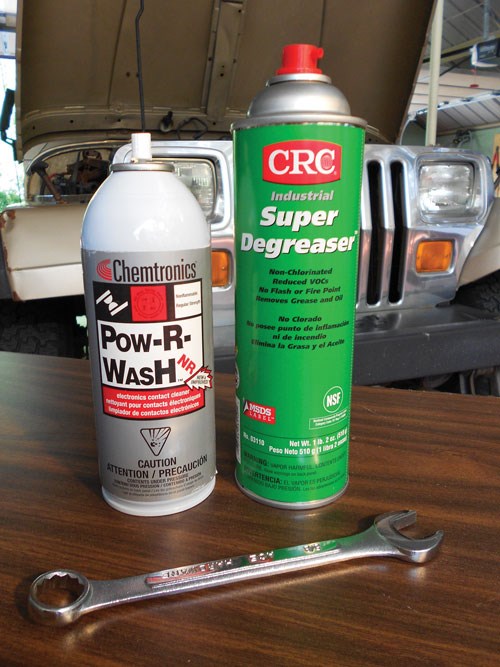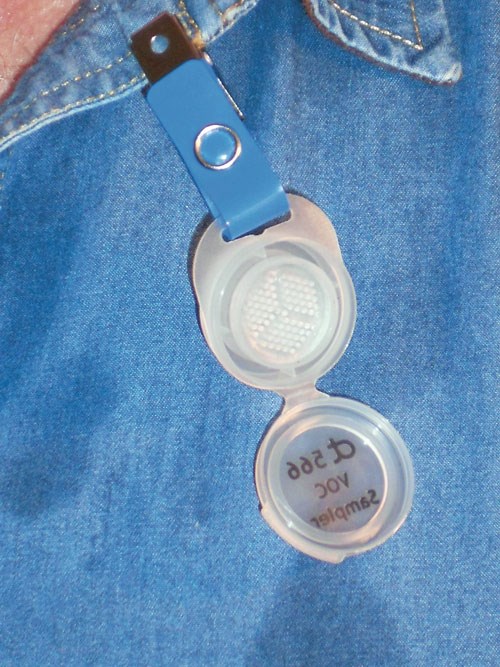Safer Cleaning Choices Replace nPB Aerosols
A small premium in the price for worker safety.
Choices are fun. Having lots of choices suggests new ideas and exciting directions. A world full of choices is a world full of promise and potential.
Such is the situation for companies using aerosol cleaners packaged with a chemical called normal propyl bromide, also called nPB. This material is a great cleaner and is affordably priced, but it carries serious toxicity worries.
Many users don’t realize there are safer choices. Let’s take a look at the real options.
Normal propyl bromide is a nonflammable organic solvent based on the element bromine. The fluid has a molecular formula of C3H7Br. It is often used as a replacement for methylene chloride, perchloroethane (“perc”) and trichloroethylene. Bromine is used in a wide variety of industrial applications such as fire retardants, water purification, pesticides and drugs, including sedatives and antihistamines.
A subset of the bromine product range is n-propyl bromide. This is the solvent version of bromine. It also is called 1-bromopropane in addition to other names. To determine if you are using nPB, examine the aerosol can or the safety data sheet. Specifically, look for an ingredient with the Chemical Abstract Number (CAS #) 106-94-5. If it’s there, no matter what name they give the ingredient, it’s nPB.
Toxicity Ratings
David Ferguson, MicroCare product manager for precision cleaners, notes that most end users do not understand toxicity ratings, as they relate to their application.

Sixteen companies advertise on the web aerosols packaged with nPB.
“Most exposure limits are time-weighted, designed to prevent long-term damage from exposures lasting days, weeks or even years,” he says. “But this does not take into consideration how the chemical is used. For example, a chemical with a lower exposure may be acceptable when used in properly designed cleaning equipment. However, using this same chemical in a highly emissive application, such as spraying, could be very dangerous for workers.”
Toxicity ratings are expressed in parts-per-million (ppm). Like bowling scores, high scores are better—they indicate a safer product. High numbers, approaching 1,000 ppm, indicate a safe chemistry that is relatively harmless while lower numbers indicate a greater risk. The basic goal is to protect workers from dangerous exposures over an 8-hour workday, 40 hours per week, over a 40-year working life. Here’s the punchline: The toxicity rating for nPB is very low, generally in the single digits. So there is a serious question about the safety of using it in aerosol packages.
A common response to the toxicity issue is legalistic. Some people suggest that since nPB is not regulated by any government agency, there is no need to control employee exposures. However, the courts have a different way of looking at things, as a lawsuit from New England revealed in the 1990s.

An air quality monitoring badge.
The case involved a large metal-working manufacturer that used large quantities of TCE, a chlorinated solvent with known toxicity worries. The company was fairly sanguine about the chemical overexposures because, just like nPB today, TCE was not regulated. However, two decades later, former employees took the company to court due to cases of leukemia attributed to TCE overexposure. The company lost the battle and paid millions in reparations to victims, not to mention the distraction and costs of the legal processes.
In short—if you have good, people-safe chemical alternatives, deploy them early and document your efforts to keep your workers safe.
nPB Hazards
Due to a lack of clinical toxicology studies, the original toxicity level for nPB was thought to be around 100 ppm, but the solvent was rarely used because alternatives were available. After the completion of preliminary exposure studies in 2004, the toxicity rating of nPB was lowered to 25, which is low but manageable; it should not automatically “disqualify” a cleaning fluid from industrial uses. Proper storage and handling procedures, along with protective equipment, can manage the risks of short-term overexposure.
Newer toxicology studies found nPB seriously damaged the nervous system with symptoms including headaches, slurred speech, difficulty walking, and/or loss of feeling in arms and legs. In 2004 n-propyl bromide was found to alter human DNA and have deleterious effects on male and female fertility. Based on these reports, the National Toxicology Program (NTP), OSHA and the EPA recommended 10 ppm as the proper exposure limit. Separately, California adopted a 5 ppm limit.
More studies discovered potentially carcinogenic effects. (While nPB is not listed as a carcinogen today, it is under review by the U.S. National Toxicity Program.) In 2013, the American Conference of Industrial Hygienists (ACGIH) lowered its recommended nPB safety rating to 0.1 ppm. A flurry of lawsuits resulted from that recommendation, but it is expected the 0.1 ppm number will become the industry standard in the years ahead.
In short, while nPB has been an acceptable choice for precision cleaning in tightly-sealed cleaning systems for years (see: Federal Register, May 30, 2007), the use of nPB in aerosols is still “proposed” to be an unacceptable. However, even after all these years the final ruling has not been published. So the chemical legally could be packaged in an aerosol can because the rule has not been finalized. In my personal opinion, any company packaging nPB in aerosol cans is walking a fine line, selling an aerosol product that is technically legal today but burdened with known toxicity issues.
MicroCare does not package nPB into aerosol canisters. It is almost impossible to use any fluid in an aerosol package and keep exposures below 10 ppm, much less the proposed new exposure level of 0.1 ppm. Testing at MicroCare years ago determined that under the best of circumstances exposures for workers using aerosol cans are in the 10-20 ppm range (with a TriggerGrip dispenser from MicroCare or similar tool) and one could expect uncontrolled, high-pressure aerosols to generate substantially higher exposures.
But here’s the key question: Are the purported replacements for nPB up to the job? Can customers stop using nPB and switch to newer and safer cleaning products? For that answer, a simple field test seems well-justified.
Field Tests
The criteria for which customers should be searching are clear: a nonflammable, fast-drying, highly aggressive solvent that cleans great, doesn’t damage the environment and has acceptable toxicity ratings.
Most companies using aerosol degreasers use a simple “visual inspection” to confirm the parts are clean enough. Conversations with operators confirm they are looking for fast, safe, convenient “good enough” cleaning. A good location to test cleaning results was at a local auto transmission repair shop, which was kind enough to open its workshop to our cleaners and photographer.
As the photos show, auto parts are heavily contaminated with dirty lubricating oils. These can be considered typical of the industrial cleaning applications found in almost every factory around the world. Gears, levers, push-rods, conveyor systems and actuators of all sorts become covered in dirt, dust and debris over time. These must be cleaned before repair.
In this real-world field test, a variety transmission parts were cleaned with two different nPB aerosol cleaners and one HFC-based aerosol cleaner. Cleaning was enhanced by scrubbing the parts with a stiff brush. Operators judged the cleaning effectiveness to be very good on all three products even when the residues were baked in place. When the parts were placed side-by-side after cleaning, operators could not detect a difference between the parts cleaned with nPB and the parts cleaned with HFC-trans blends.
Both types of chemistry definitely are not “plastic-safe.” As a side-by-side test of their cleaning strength, the sprays were aimed at a soft plastic foam product. Both destroyed the foam instantly. This suggests that in terms of cleaning strength the materials operate in a highly similar manner.
Operators observed a few interesting differences. The nPB-filled aerosols were packaged at higher pressures than the HFC-based cleaner, so those cleaning fluids came out faster and with more “scrubbing” power. This obviously is a function of the packaging and not the cleaners themselves.
The operators also commented that the HFC-based cleaner evaporated faster than the nPB-based cleaners. Since nPB boils at 70˚C, about 40˚C higher than HFC blends, it should evaporate more slowly. This observation caused some divergent opinions. One operator thought fast-drying was convenient, and allowed him to work more efficiently. The other operator felt he used more solvent because it evaporated so quickly.
Both operators noticed the HFC-based cleaner had far less aroma than the nPB-based cleaners and both felt this was a significant improvement. Nobody, it seems, likes smelly chemicals, even when they work really well.
MicroCare provides air monitoring badges to clients using nPB purchased from MicroCare, so during the tests, one tech wore a badge on the lapel of his work shirt. This unobtrusive device “sniffs” the air and provides insights into the environment surrounding the operator. After cleaning, the badge was sealed and sent to the lab for testing.
Results indicated the operator had been exposed to approximately 20 ppm of nPB during the 2-hour test session. This suggests the exposures from even this simple test put operators over the latest OSHA, EPA and ACGIH exposure limits and puts employers using nPB at substantial liability. Savvy companies will use the badges to make changes in processes (e.g., better training, better ventilation, or other steps) if worker exposures change.
The Choice Is Yours
Many industrial customers need a strong, nonflammable aerosol degreaser. However, it is clear there no longer is any need to use nPB-based aerosols. While these tests were not rigorously scientific and were conducted with a very small sample, these admittedly anecdotal conclusions strongly suggest that today there are viable choices on the market that are substantially safer than nPB.
It seems reasonable that any well-informed company buying an aerosol with nPB should be looking to change as soon as possible. Furthermore, any distributor selling aerosols filled with nPB aerosol should be concerned about product liability. Everybody should be helping their operators select and procure a newer, safer cleaning fluid.
While companies may pay a small premium in price for these products, the improvements in worker safety are substantial.
Originally published in the August 2015 issue.
Related Content
Replacing Open-Top Vapor Degreasing in Aerospace Manufacturing
Options and considerations for cleaning aerospace parts as regulations tighten on vapor degreasing solvents.
Read MoreAdvantages to Pumped Eductor Agitation
Not all agitation methods are created equally. Pumped agitation with eductor nozzles can improve process tanks and quickly show a reduction in operating costs while keeping staff safe, following environmental legislation and preventing pollution.
Read MoreImproving Wastewater Management Efficiency
Don’t find yourself underwater when managing wastewater processes. Follow these steps to improve efficiency and determine the best ROI.
Read MoreRead Next
Delivering Increased Benefits to Greenhouse Films
Baystar's Borstar technology is helping customers deliver better, more reliable production methods to greenhouse agriculture.
Read MoreA ‘Clean’ Agenda Offers Unique Presentations in Chicago
The 2024 Parts Cleaning Conference, co-located with the International Manufacturing Technology Show, includes presentations by several speakers who are new to the conference and topics that have not been covered in past editions of this event.
Read MoreEducation Bringing Cleaning to Machining
Debuting new speakers and cleaning technology content during this half-day workshop co-located with IMTS 2024.
Read More





















